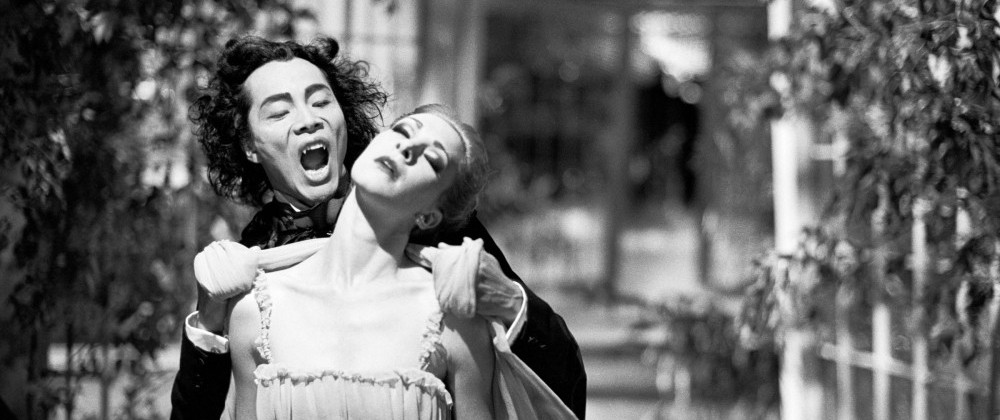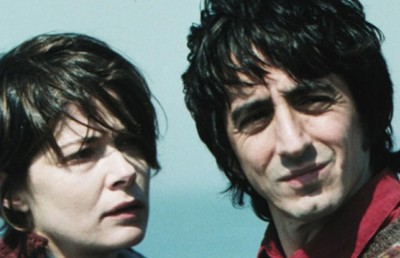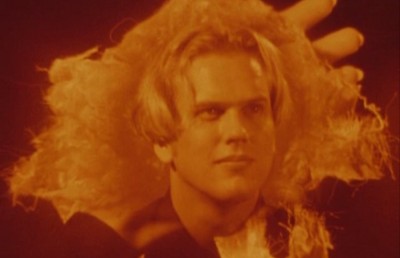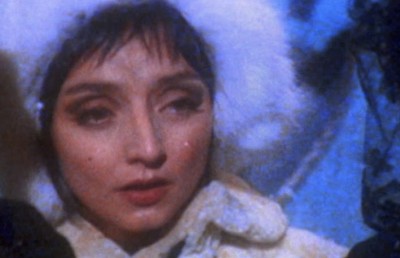Transplant, Consumption, Death, Or: Disease, pathology and decay in Guy Maddin’s cinema
Surveying Maddin

“It’s so liberating to be self-destructive, at times!” (Guy Maddin)
“I’m a gentle, quiet director who seeks viewer involvement. I’m working towards beauty, placidity and exquisite strangeness.1 (Guy Maddin)
The latter quote seems nothing short of an understatement for a director whose work has been compared to that of David Lynch (a comparison Maddin is quick to question: “the only thing we have in common is we’ve both made a couple of monochrome picture”2, Cocteau, Buñuel, Eisenstein, and Tim Burton. It’s a hard-to-swallow premise as well, given that Maddin’s films look like genuine decaying prints that have survived innumerable screenings over many years, yet they constantly remind the viewer that “what they are watching fully belongs in neither the past nor the present, but seems to exist in a sort of limbo state, as a hybrid of elements, a decaying past made unnaturally fresh again.”3 The first reaction is of uneasiness and perturbation; and it’s tempting to give up and label the whole output of the Winnipeg-based director as a sterile, formalistic and cerebral divertissement. Yet, under an elaborate aesthetic/scenographic display which exhumes and reinvents themes, techniques and clichés that belonged to primitive moviemaking, there is a warmth and an empathy that the vast majority of today’s mainstream cinema lacks.
Maddin slashes and stains his films with filters, as well as visual and aural trick [4] (scratches, jumps and creaking sound) that are tangible signs of consumption of an art whose unending change (or perhaps mutation?) threatens to slip out of our hands. But they are also tricks to have us face the ineluctability of time, as well as the sad necessity of getting old and finally fading out, in a world whose main aim seems to be the complete dismissal of the idea of mortality itself.
There are many signs of death and disease across Maddin’s body of work: his films are full of solitary people marked by traumas and wounds, sores and mutilations, and subject to violent bouts of self-destruction. Maddin’s characters look and act as if they have stepped out of an old expressionist film, yet are made of flesh and blood, and their corrupt, mutilated and suffering bodies exude an outstanding physical quality. His characters are celluloid prisoners: just like Pedro P., the protagonist of Iván Zulueta’s Arrebato (1979), who ended up being sucked in by his own camera, disappearing from the material world, only to become an image impressed on film. Trapped in a bi-dimensional universe, deadened and obtuse, made of black and white or unreal pastel colours, these characters bear every kind of vexation and humiliation, yet maintain their dignity. Maddin is on their side: he lets them live their own obsessions and shortcomings, and follows their steps with amazement, combined with a tender, sympathetic irony.
Maddin’s heroes have so many common passions and idiosyncrasies, that they actually seem like variations on a single character, who more or less directly recall the director himself. The autobiographical theme, which was latent from Maddin’s first short The Dead Father to 2003’s The Saddest Music in the World (which is set in the director’s hometown Winnipeg), becomes central in _Cowards Bend the Knee_5, originally a gallery installation which is nothing but a sardonic auto-da-fé in which Maddin goes for excess, but is disarmingly sincere about himself. “Given my past history as a little boy who drilled holes in things and looked through them, creating a chance for the spied-upon world to get revenge by looking in on me might be a great way to masochistically even the score!”6
The main character is Maddin himself (played by Darcy Fehr), and Cowards is a mad imaginary autobiography whose chapters recall a variety of old movie classics, from Tod Browning’s The Unknown (1927) to Karl Freund’s Mad Love (1935). That’s because Maddin still believes in cinema as a mythopoetic apparatus: in Tales from the Gimli Hospital the image of a blind man groping in the dark like the Frankenstein monster is less a reference to Whale’s film than to the essence of suffering and solitude that the Karloff character embodies within the director’s own imaginary – and ours as well.
Maddin adopts the form of melodrama, but a peculiar one, corrupted and genetically altered with horrific and fantastic elements: “One of my life’s ambitions is to redeem the name of melodrama, which remains the most enduringly popular cinematic art form all over the rest of the non-English-speaking world, though we treat it as somewhat of a cheesy bastard stepchild.”7 Maddin’s exploration of human emotions (often “improperly expressed or outright blocked,” as one critic noted.8) assumes absurdist tones and demands fairy-like scenarios. As in Tales from the Gimli Hospital, whose framing story adopts a device similar to that of a fairytale: in the titular hospital, two children standing at the bedside of their dying mother are being told a story by their old maid of love, death and jealousy that took place years earlier9 and the principal tale contains others, in Chinese box fashion. Tales from the Gimli Hospital features the first of Maddin’s leper houses of the soul: the snowy papier-mâché Russia of Archangel, the isolated Alpine village of Tolzbad in Careful, the isle of Mandragora, where the sun never sets in Twilight of the Ice Nymphs, and eventually the Depression-era Winnipeg in The Saddest Music in the World. In a sense, Saddest Music is a sort of homecoming to where everything had started: a town swept by the icy winds of the North, a self-restrained universe that has influenced Maddin’s cinematic no man’s lands.
“Perhaps the boy has mountain fever. It begins innocently enough, with dreams of mountains: a peak round as a plump knee, or a crest like a frosted bosom, white as goat’s milk. Who could resist the temptation to climb?” (Careful)
Maddin’s characters live love like a pathological condition: a feverish perturbation, an upsetting and destructive conflict between the senses and reason. Terrorized by the opposite sex, they simply cannot live a normal love relationship. In Tales, what really distresses Gunnar (Michael Gottli) and Einar (Kyle McCulloch), the two inmates occupying adjoining beds in Gimli hospital during the smallpox plague, is actually love. Jealously, fear and possessiveness make Gunnar lose his beloved Snjófridur, whereas Einar “the lonely” is an unforgettable Keatonesque clown whose autistic clumsiness leads him to incommunicability towards women: in order to groom his hair and make himself attractive for the local girls sunbathing on the beach near the shack where he smokes fish, Einar frantically squeezes a dead salmon over his head, until its guts are wretched open, spilling fish oil all over his hair as if it was grease. But he just can not manage getting in touch with a woman; even the nurses at the hospital systematically ignore him, as if he were dumb or just plain invisible.10
In Archangel, everybody loves the wrong person, in a tragicomic ronde of amnesias and agnitions that rivals Wong Kar-wai’s Ashes of Time for sheer complexity. Not only do lovers incessantly seek and lose each other, they also plagiarize and hypnotize the object of their desire, only to be left alone or in mismatched couplings. Twilight of the Ice Nymphs revolves around the same basic plot, in a magic setting that is half A Midsummer’s Night Dream and half Aubrey Beardsley. In Twilight, Maddin has a mesmerist, Dr. Solti (R. H. Thompson), manipulate other character’s feelings; and like in Merimée’s La Venus d’Ille, an unearthed statue projects its influence on people.
The form of a moral tale returns in Careful, a tragedy told as if it was an absurdist comedy, or vice versa (scriptwriter George Toles refers to it as a “pro-incest” movie), that is strongly influenced by Melville’s Pierre or the ambiguities. “It’s about people who love each other but who can’t express their affection.” Maddin explains, “this over-caution insidiously infects every part of their lives. It’s partly autobiographical. My family are infuriatingly cautious – like the whole of Canada.”11 In the opening sequence, elderly herr Trotta (Victor Cowie) tells rules in the form of parables to an audience of young boys: the fathers’ constrictions – to repress emotions, and keep everything inside – affect sons. And this is splendidly expressed through the use of the chromatic palette (most sequences consist of bi-chromatic compositions, while others feature colours so saturated that they appear to drip off the screen).
In the village of Tolzbad – where, for fear of snow slides, animals have their vocal chords slit and humans speak in whispers – young Johann (Brent Neale) dreams of making love with his mother, while his fiancée Karla (Sarah Neville) lusts over her father, who in turn is attracted to his other daughter. Unsatisfied desire deflagrates like a disease, a “mountain fever”. In other Maddin films it assumes other pathological forms, like somnambulism, which is the case with Einar in Tales, or in Twilight of the Ice Nymphs, where Peter (Nigel Whitmey12) goes “sleep hunting”. At times, the end result is necrophilia. For example, in Tales Einar violates the body of Gunnar’s wife13; in Careful, Johann has his mom drink a glass of milk spiced with drug, in order to make love to the woman as she is sleeping. While in Twilight the result of the repression is sheer madness, with Amelia (Shelley Duvall) turning into a pyromaniac and a murderess in the film’s bitter climax. Likewise, acts of love lead to tragic consequences: Gunnar contaminates Snjófridur, who keeps growing scars all over her body and eventually dies on their wedding night; while post-coitum is unbearable: as in Twilight, where Peter shoots a bullet into his own feet after being abandoned; and Archangel, where lieutenant Boles [Kyle McCulloch] undergoes a cure with a machinery that looks like a horror-movie version of Wilhelm Reich’s orgone machine, and ends up a bleeding and dazed zombie; and in Careful, where Johann uses drastic means to punish his incestuous impulses. As one might expect, in Maddin’s universe there is no room for happy endings. In Twilight, Zephyr (Alice Krige) is crushed by the statue of Venus, while Peter is left alone on Mandragora with his sister Amelia. In the film’s last image, Amelia, now completely mad, desperately begs to be kissed.
In Maddin’s films hysteria and parody co-exist, but the latter does not undermine the melodramatic element. Take as an example Archangel’s opening boat sequence, where Boles’ grieving farewell to his beloved Iris (whose ashes are kept in a bottle) is ruined by the ship’s commander, who mistakes the urn for a bottle of liquor and throws it off board, thus inadvertently celebrating a form of funeral at sea. Boles leaves, hopping on his only leg in a dignified manner, then returns to take the artificial limb he had forgotten behind. The effect is irresistibly funny, yet Maddin does not invite us to laugh at Boles, but rather at the absurd events set in motion by the capricious hand of Fate.
“We each bear many scars” (Archangel)
In Tales from the Gimli Hospital, the signs of smallpox on the faces of Einar and Gunnar are accompanied by the scars of their memory, and the sores that mark their bodies are rather a psychosomatic manifestation of their craving for love. Tales deals with pustules and purulent wounds, surgery without anaesthetics and lovemaking scenes in which scars are exposed and caressed with an enthusiasm that predates Cronenberg’s Crash (1996). In Archangel, faces are slashed, disfigured and covered with blood, while bodies suffer from apoplectic fits, are exposed to the effects of mustard gas, and eventually die in painful agony.14 Maddin sporadically relies on over-the-top gore effects, a proceeding that breaks the unwritten rules on what can and can not be shown within a context that openly recalls silent movies; at the same time, the director literally reinvents gore, giving it a symbolic meaning that makes it perfectly pertinent and even more powerful. When the fat, cowardly Jannings (Michael Gottli) is pierced in the belly by the Bolsheviks, his guts burst out of the wound; in a desperate act of heroism, he puts his innards back into his belly and throws himself over to the enemy, dispatching them with his bare hands and even strangling them with his own intestines. On paper, this sounds like something that would not be out of place in a Aristide Massaccesi film (Anthropophagus’ clamorous ending has Luigi Montefiori greedily biting his own guts) or in some nasty Hong Kong Category III flick.15The stylized and primitive shoestring budget gore effects are accompanied by title cards that border on the grotesque (“Strangled by an intestine!”).16 Yet the scene becomes poignant and pathetic when the man’s young son, unaware of his father’s sacrifices, insults his memory (“We just buried a coward”).
One of Maddin’s obsessions is the theme of physical mutilation. In Archangel Lt. Boles has only one leg, like Dr. Solti in Twilight of the Ice Nymphs; while in The Saddest Music in the World Lady Port-Hunley (Isabella Rossellini) is missing both legs, and has them replaced by glass prosthetics filled with beer. The loss of a limb recalls the loss of a loved one: it is impossible to replace them, even with an imperfect surrogate. At times, these mutilations are self-inflicted, and become a form of retaliation, as happens in Careful, where Johann punishes his own incestuous excesses by scalding the mouth that kissed his mother’s breasts with a red-hot stone, then cuts the fingers that caressed it with a pair of shears.
But most of all, Maddin’s characters suffer from the absence of a paternal figure. In Maddin’s first short, The Dead Father, we find a father who is physically dead, but whose image keeps obsessing his son. Careful is full of absent, incestuous or blind fathers.17 Oedipal conflicts end with ritual parricide, or even cannibalism: in The Dead Father the main character dreams he is eating spoonfuls of flesh from his dead father’s body.
“Good ghosts wander in battlefields at night, guiding soldiers out of danger.” (Archangel)
In Noam Gonick’s 1997 documentary Guy Maddin – Waiting for Twilight, Maddin tells how after a bad cold which degenerated into a neurological infection, he developed the feeling of being touched by invisible hands all over the body, and jokes about following their instructions when it came to deciding where to place the camera. As a matter of fact, his films are filled with ghosts. Death is a permeable state: the living see the dead, and the dead come back to the living (coffins opening in The Heart of the World, the apparitions in The Dead Father), or simply pass before our very eyes, as the enigmatic procession of veiled dames that separates Careful’s part one and two. Often the results are astonishingly touching: the image of the three little girls’ coffins carried away by the river – “Were they dead, or were they merely sleeping in the quiet boxes borne along by the water of the sad Icelandic river?” – and the bizarre sequence of the Indian funeral in Tales from the Gimli Hospital; or the dead boy’s soul coming out of his body and joining his father in Archangel; and the angels assisting the living in the opening and closing sequence of Tales from the Gimli Hospital.
On Earth we are doomed to suffer. Maddin is well aware of our ephemeral nature, yet he still cultivates a hope of immortality. Perhaps it is because of a sense of modesty and unconscious self-defense, that the ineffability of death often turns into ridicule. Like in Careful, where the dead father’s ghost appears just like Polonius in Hamlet… complaining that his new condition did not make him get his sight back.
“Will angels put us back together again like bits of a broken statue, or will we look as we did when we were young and healthy, before we were sick or fat or old?” asks Shelley Duvall in Twilight of the Ice Nymphs, adding: “There must be a place where all our bodies have a chance to be loved.” A loving attention for the human body exudes from the whole of Maddin’s work: a case in point is the sequence of the youngsters waking up and dressing in Tales from the Gimli Hospital, where the skin’s whiteness literally lightens the frame. Movies collect and put aside these moments of casual and frail beauty, preserving them from decay and putrefaction. Maddin shows an unshakeable faith in the thaumaturgical power of the Seventh Art: the most outstanding example is The Heart of the World, an amazing six minute short that shows how our planet’s dying heart is literally healed by the epiphany of cinema, whilst paying homage to Aelita (1924, Yakov Protazanov) and Abel Gance’s La fin du monde, with the accompaniment of Georgy Sviridov’s thundering notes. A sincere and passionate promise of immortality.
1 Alan Jones, Far from the Maddin Crowd. Guy Maddin Interviewed, Shock Xpress 1, p.147.
2 Ibid.
3 Jason Woloski, Guy Maddin, in Great directors – A critical database, Senses of Cinema (www.sensesofcinema.com).
4 [4] Maddin’s statement (in the audio commentary of the Careful dvd) that he resisted the temptation to digitally alter the film’s chromatic palette for the dvd release is quite significant, in an era of special editions and director’s cuts.
5 The installation was originally divided into ten chapters, each 6 minutes long, that had to be viewed through peepholes.
6 Jason Anderson, Far From the Maddin Crowd – Guy Maddin installs himself in Toronto, Eye Weekly, 20.3.2003.
7 Gemma Files, Guy Maddin’s Groovy Skull, Eye Weekly, 9.18.1997.
8 Woloski, Guy Maddin cit.
9 Maddin takes inspiration from a historical occurrence: the smallpox plague that spread over the Gimli community in 1876.
10 In the film Kyle McCulloch, his face painted black as in Griffith’s The Birth of a Nation, also plays a minstrel, who’s sort of Einar’s double. It’s the minstrel’s death that deprives Einar (who is about to tell the nurses a tale of his childhood in order to rival Gunnar’s storytelling skills) of his only chance to be at the center of the nurses’ attention. “And the story was left untold,” the narrator concludes: the untold story becomes a metaphor of Einar’s erotic frustration.
11 Jones, Far From the Maddin Crowd cit., p. 147.
12 The name of English-born Whitmey does not appear in the credits, though, because of his disagreements with the director over the finished film: during post-production, his voice was dubbed by Canadian actor Ross McMillan.
13 While recounting the necrophiliac act, Einar justifies his feverish excitement with the influence of the new moon (“My head was very dizzy with the ebony moonbeams of that black night.”).
14 “Dispatched by wounds innumerable,” is the line inscribed on the wreath that pops up several times in the film, in a neat biblical reference.
15 The image of a man who strangles his adversary by using his own intestines can also be found in Nam Nai Choi’s Story of Ricky, as well as in Zhang Che’s Shoalin Martial Arts, where the overall effect is closer to the spirit of Maddin’s film.
16 “I had hired a make-up effects guy to sculpt an intestinal panel. He wanted to charge $1,500 and I could tell he’d be a problem. Shit, I said, let’s get a pack of sausages and do it ourselves. We untied the links, smoothed them off and it cost $30.” Jones, Far from the Maddin Crowd cit., p.146.
17 In one of the film’s opening vignettes, we see how Grigorss’ and Johann’s father had lost an eye at an early age because his mother held him to her chest and accidentally pierced his eye with the pin of her broach (an episode apparently inspired by an incident that happened to Maddin’s father, and which is also referred to in Archangel).














